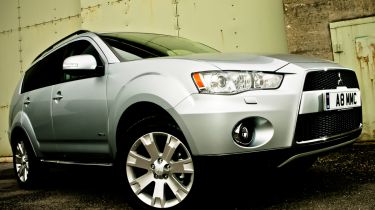Mitsubishi Outlander (2007-2013)
The Mitsubishi Outlander is a compact SUV that's good to drive and great to live with

Described as a crossover rather than a dedicated 4x4, the Mitsubishi Outlander shares its platform with the Citroen C-Crosser and Peugeot 4007. With its bulging wheelarches, angular headlights and tough metal-look lower front bumper, it certainly stands out, although we think the C-Crosser is prettier. The Outlander is powered by a 2.2-litre diesel that has plenty of power, but it's not the cleanest engine around. Inside, top-spec models get plenty of kit and there's seven seats - although the final row is a token gesture, and only really suitable for kids.
Engines, performance and drive
On the road, the Outlander feels assured and composed. It's based on a platform that also underpins the latest generation Lancer saloon, which means the compact SUV feels very car-like to drive. Of course, in tight corners it suffers from more body roll than your average hatchback, but the steering is accurate for such a big machine and the ride is comfortably supple. Clever variable four-wheel-drive offers three distinct modes. On the road, drivers can swap between front and four-wheel drive, with the twist of a knob on the transmission tunnel. If conditions become more treacherous, there's a low-range setting that offers extra traction.
MPG, CO2 and Running Costs
Power comes from a 174bhp 2.2-litre diesel, and while it's got plenty of overtaking power, it's not the cleanest engine available. Emissions of 167g/km for top-spec cars lag behind rivals such as the VW Tiguan, and fuel economy of around 44mpg isn't that great, either. What's more, go for Mitsubishi's SST automated manual, and not only do these figures get worse, but there's only 156bhp to play with.
Interior, design and technology
As with most other cars in the range, the Mitsubishi Outlander takes design inspiration from the sporty Evo X saloon. That means a large grille up front and squared-off headlamps, while the flared wheelarches and roof rails are typical SUV touches. Inside, it's a relatively dull affair. The layout is similar to the Lancer's, and while it's well built, the hard plastics are a letdown.
Practicality, comfort and boot space
The Outlander's extended tail means there's room inside for a standard set of seven seats on all but entry-level models. While the rearmost bench is meant only for children, the extra chairs are a big bonus in this sector. However, they appear to be an afterthought, and the pull cord handles mean the system is awkward to use. At least the spacious second row is more flexible, splitting 60:40 at the touch of a button. Up front, the dashboard is clearly laid out, if a little dull to look at. Flagship versions get a seven-inch touch screen central display, while the driver's seat offers an excellent view of the road ahead.







